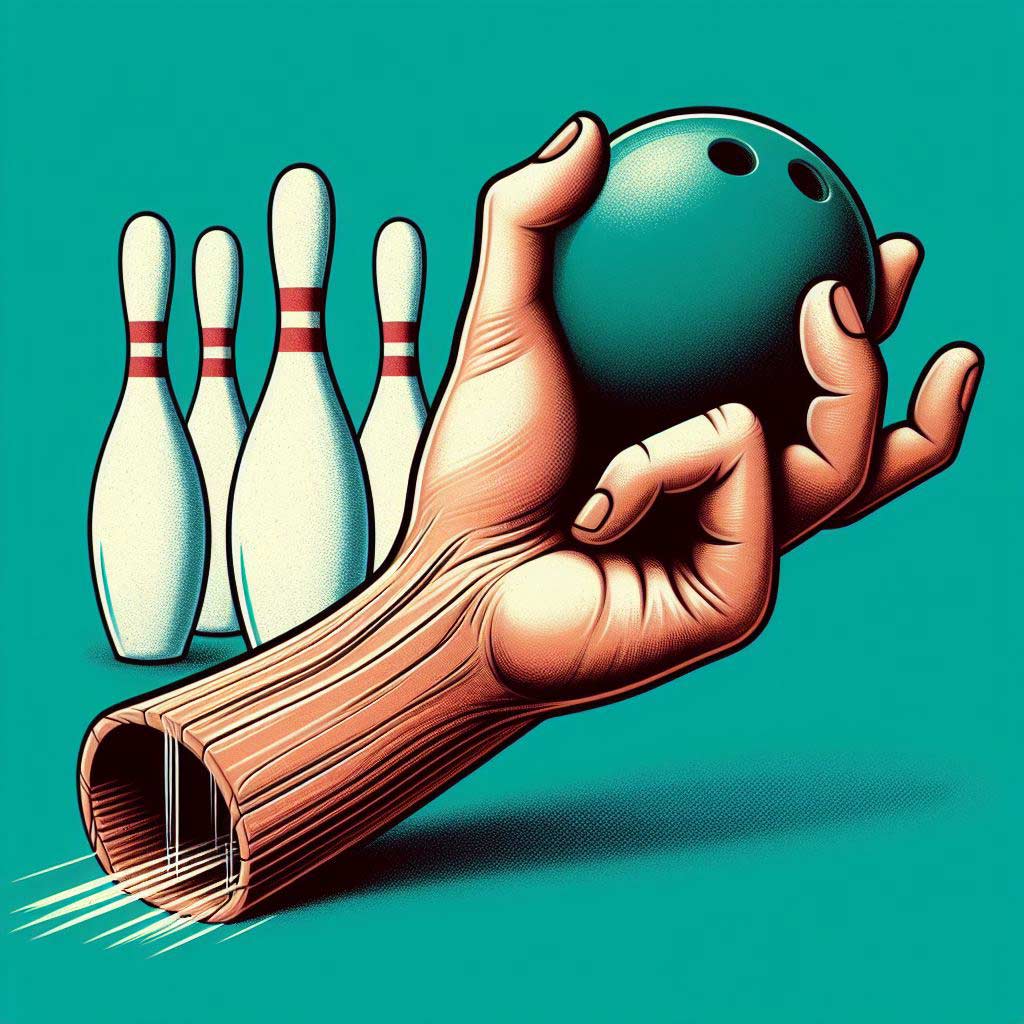Bowling is a popular sport that people of all ages enjoy. However, repeatedly throwing a heavy bowling ball can put a lot of strain on the wrist joint, making wrist injuries a common occurrence for avid bowlers.
Pain and inflammation in the wrist area can significantly impact performance and enjoyment of the sport. Learning proper bowling form, taking preventative measures, and treating wrist pain appropriately are key to staying healthy on the lanes.
In this comprehensive guide, we’ll cover the causes and types of common bowling wrist injuries, provide tips to help prevent them, and outline treatment options to find relief. With the right knowledge, bowlers can continue striking down pins for years to come.
Anatomy of the Wrist Joint
To understand how wrist injuries occur, it’s important to first briefly review the anatomy at play. The wrist joint connects the hand to the forearm and allows flexibility in positioning the hand.
It contains multiple small bones called carpals along with connections between the radius and ulna forearm bones and metacarpal hand bones.
Ligaments, such as the ulnar collateral ligament on the thumb side, connect these wrist bones and provide stability. Tendons attach muscles of the forearm to bones in the hand. The median nerve also passes through the wrist on its pathway from the forearm to the hand.
This complex structure of bones, ligaments, and soft tissues allows the wide range of motion required for bowling. However, repetitive stress from the motions involved can strain this delicate area over time. Proper wrist alignment and not overextending are crucial during the bowling release to prevent injury.
Causes of Bowling Wrist Injuries
Bowling wrist injuries mainly arise from two factors – repetitive stress and improper bowling mechanics. Let’s explore these key causes:
Repetitive Stress
The most common reason bowlers experience wrist pain is due to repetitive stress from the bowling motion. Each time the ball is launched down the lane, force is placed on the tissues of the wrist joint.
Bowling multiple games during league nights or tournaments puts added strain on the area with no time for recovery. Overuse over time can lead to inflammation and small tears.
Bowlers who bowl frequently without allowing the wrist adequate rest between sessions are most at risk. Even just weekly league bowling if done for years without preventative care can take its toll on the wrist joint. The repetitive nature of bowling makes wrist injuries an occupational hazard.
Improper Bowling Mechanics
The second key contributor to wrist injuries is using flawed bowling mechanics. If the wrist is not properly supported and in the right position during the bowling release, unequal force is placed on the joint. This increases strain and the risk of injury.
Problems often arise from backswing issues, gripping the ball incorrectly, rushing the release, and improper follow-through. Excessive bending back of the wrist, twisting, improper fit of the ball, and not keeping the wrist straight can also cause problems.
Without professional instruction and analysis, it’s easy to develop bad habits that put extra pressure on the wrist joint. Attempting to add speed or more hooks on the ball by forcing the wrist into unnatural positions makes the problem worse over time.
Other Causes
While repetitive stress and poor form are the two main culprits, other bowling injury risk factors include:
- Bowling too frequently without rest days
- Using a ball that is too heavy
- Not warming up the wrist properly
- Insufficient wrist strength and flexibility
- Bowling through wrist pain instead of resting
- Underlying medical conditions like arthritis
- Age-related changes in the wrist joint
Now that we’ve covered what typically causes bowling wrist injuries, let’s go over the most common injuries bowlers sustain.
Types of Bowling Wrist Injuries
Bowlers are prone to several types of injuries in the wrist area from the repetitive motions required. These include:
Bowler’s Wrist (De Quervain’s Tenosynovitis)
One of the most frequently experienced wrist problems by bowlers is De Quervain’s tenosynovitis, also known as the bowler’s wrist. This overuse injury causes inflammation of the tendons on the thumb side of the wrist.
The tendons affected run from the forearm muscles to bones in the wrist and thumb. As they slide through the first dorsal compartment in the wrist, irritation and thickening can occur. This exerts pressure on the tendons causing pain when moving the thumb or grasping objects.
Ulnar Collateral Ligament (UCL) Sprain
The ulnar collateral ligament (UCL) connects bones on the outer thumb side of the wrist. This ligament provides stability and allows proper positioning of the wrist when bowling. However, forcibly bending the wrist during the release of the bowling ball can overstretch this ligament resulting in a painful sprain.
Symptoms include pain on the thumb side of the wrist that increases with bowling. As with pitcher’s elbow, UCL sprains are common with repetitive overhead throwing motions like bowling.
Carpal Tunnel Syndrome
Carpal tunnel syndrome is another prevalent wrist problem among bowlers. In this condition, the median nerve running through the wrist becomes compressed leading to numbness, tingling, and pain in the wrist, hand, and fingers.
The repetitive wrist flexion during bowling irritates the nerve over time. Symptoms often worsen at night disrupting sleep. Carpal tunnel can make gripping and releasing the ball difficult.
Fractures
While less common than soft tissue repetitive strain injuries, fractures can occur in the wrist bones or metacarpals of the hand. A fall while bowling could cause such a traumatic injury.
However, stress fractures of the hamate or other wrist bones can also develop from repetitive bowling impact. Osteoporosis increases fracture risk. Broken bones usually require immobilization for proper healing.
Preventing Bowling Wrist Injuries
Bowlers don’t have to resign themselves to wrist pain or early retirement from the sport due to injury. While not all bowling wrist problems can be entirely avoided, focusing on prevention greatly decreases the rate and severity of issues.
Here are some proactive tips to help bowlers steer clear of wrist injuries:
Use Proper Bowling Form and Mechanics
Having a knowledgeable coach analyze bowling form and make necessary corrections is the number one preventative measure. Keeping the wrist in proper alignment reduces strain tremendously.
Key form tips include:
- Avoid bending the wrist back excessively during a backswing
- Keep wrist straight and neutral at the release point
- Follow through without twisting or turning the wrist
- Ensure the ball is fitted appropriately to avoid grip strain
- Relax grip pressure and don’t squeeze the ball
Wear a Bowling Wrist Brace or Tape Thumb
Wearing a rigid wrist brace or taping the thumb joint can help stabilize the wrist area and restrict over-extension during bowling. This helps take stress off the UCL and other ligaments.
Braces worn on the thumb side provide the most support. High-quality neoprene or leather options allow some flexibility while preventing excess movement.
Take Frequent Breaks When Bowling Multiple Games
Giving the wrist frequent rest periods is key to avoiding overuse issues. Bowlers playing 3 or more consecutive games should take a 10-15 minute break between games to ice, stretch and recover.
For leagues and tournaments that require many games, consider using two balls – one heavier and one lighter. Alternating between balls gives the wrist a slight break.
Do Preventative Stretches and Exercises
Strengthening exercises for the forearms, wrists, and hands along with stretching help prevent injuries. These activities increase flexibility and stabilize muscles around the wrist joint.
Yoga is also beneficial for building strength and preventing muscle imbalances. Simple wrist flexing and rotating can be done before bowling as a warm-up. Staying generally active also keeps joints healthy.
Ensure Properly Fitted Ball and Equipment
Using a ball that is too heavy stresses the wrist tremendously during release. Make sure the finger hole sizes and span between holes properly fit your hand. The ball should feel secure but not require a death grip to hang on to.
Check that other equipment like shoes are in good condition and allow proper mechanics. New bowling balls may also need some surface roughness sanded down during initial use to avoid strain.
Now that we’ve covered injury prevention tips, let’s go over treatment options to find relief when bowling wrist injuries and pain occur.
Treating Bowling Wrist Injuries
If preventative measures fail and bowling wrist pain develops, prompt treatment is key to recovery and minimizing long-term damage. Here are effective treatment strategies:
Rest the Wrist Completely
At the first sign of wrist pain, bowlers should cease bowling and other activities that aggravate symptoms. This gives the injured ligaments, tendons, and nerves a chance to heal without further irritation.
Wearing a splint may be necessary to immobilize the wrist completely. How long rest is needed depends on severity. Minor sprains may heal in a few weeks, but more extensive injuries can take months.
Ice the Wrist
Applying ice packs intermittently throughout the day reduces inflammation and pain around the injured wrist area. Icing after bowling sessions can also calm down irritated tissues. Use an ice pack or bag of frozen peas wrapped in a towel for 10-15 minutes several times per day.
Take Anti-inflammatory Medications
Over-the-counter non-steroidal anti-inflammatory drugs like ibuprofen (Advil) and naproxen (Aleve) decrease swelling and pain in the injured wrist. They provide relief from inflammatory conditions like De Quervain’s tenosynovitis. Prescription anti-inflammatories may be necessary for more severe cases.
Try Physical Therapy Exercises
Once initial pain and swelling have subsided, a physical therapist can provide specialized stretching and strengthening exercises for the wrist. These help restore normal joint mobility and support the healing of strained ligaments and tendons.
PT is especially helpful after immobilization for fractures and for chronic issues like carpal tunnel syndrome. Ultrasound, massage, and other modalities are also used. Home exercise programs are designed for bowlers.
Consider Bracing and Orthotics
Wrist braces not only help prevent injury but can aid recovery after problems occur. Braces immobilize and support healing tissues, especially ligament tears. Braces and splints also decrease symptoms of carpal tunnel syndrome and tendonitis by restricting motion.
Shoe inserts called orthotics may be prescribed to correct biomechanical problems that put added stress on the wrist. Custom orthotics can be helpful when one leg is shorter than the other or the arches are very high or flat.
Seek Medical Treatment for Severe Injuries
While many minor wrist strains can be cared for with RICE (rest, ice, compression, elevation), seeking medical attention is wise for more serious injuries. An orthopedic doctor can assess the situation and provide or recommend the appropriate treatment.
Options like steroid injections, surgery, or referral to a hand therapist may be warranted for certain conditions like carpal tunnel syndrome or fractures. Working with doctors and therapists gets bowlers back in action safely.
Prevention is Ideal But Recovery is Possible
The best scenario is avoiding bowling wrist injuries altogether through preventative care. However, even with great form and taking precautions, overuse problems can still occur after years of play.
Listening to warning signs from your body and seeking treatment promptly is key to minimizing long-term damage. With a proper period of rest, bracing, physical therapy, and adjustments to technique, bowlers can get back to striking down pins.
Keeping up strength and flexibility in the wrists, hands, and arms through stretches, massage, and regular exercise goes a long way as well. Having a baseline level of fitness helps prevent and recover from repetitive stress injuries.
Don’t Let Wrist Pain Bench You Permanently
Wrist injuries are an unfortunate occupational hazard in the lives of passionate bowlers. However, being proactive with prevention, responding promptly to pain, and receiving the appropriate treatment can keep bowlers in the game for the long run.
Learning proper bowling form early on and working with coaches minimizes technique-related injuries down the road. Allowing adequate rest between play, wearing supportive braces, icing after sessions, and doing preventative exercises also help fend off repetitive stress issues.
When injuries do occur, prompt medical attention combined with adhering to RICE principles and physical therapy facilitates recovery. While rest periods can be frustrating, they allow healing to occur properly.
In most cases, bowling wrist injuries can be overcome with patience and care. With proper prevention and treatment as needed, bowlers can enjoy rolling strikes and spares for many pain-free years. Don’t let wrist pain leave you stuck watching from the sidelines.
Frequently Asked Questions
How do you heal a bowler’s wrist?
To heal a bowler’s wrist injury, the most important step is rest. Take a break from bowling to allow the irritated tendons and ligaments time to recover. Ice the area to reduce swelling. Over-the-counter anti-inflammatory medication can provide pain relief. Wearing a brace stabilizes the joint. Physical therapy exercises can help strengthen the wrist and improve mobility once initial inflammation subsides.
What is a common wrist injury in bowling?
One of the most common wrist injuries bowlers experience is De Quervain’s tenosynovitis, also known as bowler’s wrist. It causes pain and inflammation along the thumb side of the wrist from overuse of the tendons that control thumb and wrist motion.
What is the most common bowling injury?
The most common bowling injuries are to the fingers, wrist, elbow and shoulder from the repetitive motions of bowling. Bowler’s wrist, tennis elbow (lateral epicondylitis), and rotator cuff tendonitis in the shoulder are frequent issues. Knee problems can also develop. Proper technique, fitness and injury prevention reduce these overuse problems.
How long does it take for wrist tendonitis to heal?
Mild cases of wrist tendonitis may heal within 2 to 4 weeks with rest, ice, bracing and anti-inflammatory medications. More severe cases can take 6 to 12 weeks to fully recover. Returning to bowling too soon and continuing to strain the inflamed tendons will prolong healing.
Can wrist tendons heal on their own?
In many instances, wrist tendonitis can heal on its own with adequate rest and conservative treatment. But chronic, severe cases may require medical intervention such as steroid injections or surgery to fix tendon tears. So while the body can repair minor tendon inflammation alone, medical help may be needed for more significant injuries.
What is the fastest way to heal your wrist?
The fastest way to heal an injured wrist is to immediately immobilize it using a brace or splint. This allows the ligaments and tendons to rest and prevents further damage. Apply ice packs for 15 minutes several times a day to reduce swelling around the joint. Over-the-counter anti-inflammatory medication can also speed up healing.
How do I know if my wrist injury is serious?
Seek medical attention promptly if you experience sudden, severe wrist pain along with swelling, bruising, numbness in the fingers, and loss of strength or range of motion. These are signs of a serious injury like a fracture, ligament tear or nerve damage. Wrist pain that persists for over 2 weeks despite rest and conservative care warrants medical evaluation as well.
How do I know what type of wrist injury I have?
The exact type of wrist injury can be determined through an examination by an orthopedic doctor or hand surgeon. They will assess things like precise location of pain, range of motion, swelling, areas of tenderness, and will likely order imaging tests like x-rays or an MRI to view the injury. Based on the test results, they can diagnose sprains, fractures and repetitive strain injuries.
What are the symptoms of a torn wrist?
Symptoms of a torn wrist ligament or tendon can include sudden pain at time of injury, swelling, bruising, stiffness, weakness of grip, pain with certain motions, tenderness to touch, deformity or joint instability, and sometimes a pop or snap sound during the injury. Significant torn wrist injuries require prompt medical treatment and immobilization to heal properly.





